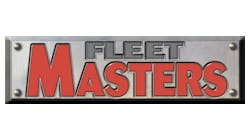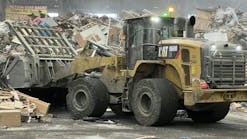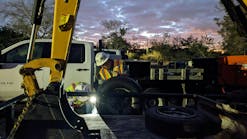Apply now for the 2014 Fleet Masters Award.
When you visit Manatee County (Fla.) Fleet Services and Michael Brennan, CEM, the county’s fleet manager, the first thing you notice in the lobby is the county’s two Fleet Masters’ trophies (2009 and 2013 winner, Public Fleet).
A second item is subtler—it’s a copy of Fleet Services’ business plan for fiscal year 2012-2013, and it’s there for a reason. “When county officials, citizens and taxpayers visit, and they do come in, I want them to be able to read our plan and understand what we’re doing,” Brennan says.
Manatee County is one of two winners of the 2013 Fleet Masters Award (Bechtel is the other one). The award is presented each year by Construction Equipment and the Association of Equipment Management Professionals (AEMP), and is judged on categories such as finance (financial management, acquisition, warranty and performance guarantees); information management (benchmarking, life-cycle costing, specifications and technology); policies (safety, employee training, environmental and human resources); and controls (outsourcing, parts management, preventive maintenance, and shop and facilities management).
Apply now for the 2014 Fleet Masters Award.
The first words a visitor would read are in bold print: “Our mission is to keep the county moving. Our vision is to be recognized by customers as continually improving their efficiency and effectiveness by providing the highest level of fleet services at the lowest possible cost.”
What politician—or puller of a fleet’s purse strings—could argue with that?
But it’s the details in the plan that show Brennan and his staff is on top of their game, essential for a county that owns a 1,318-unit fleet with a replacement value of $86.5 million. Manatee’s vehicles alone rolled more than 7.2 million road miles in fiscal 2012, while the off-road iron logged 56,000 operating hours.
“I think we do a lot of things very well,” Brennan says. “We do a lot of analytical work to put value on our processes and procedures and that value is the cost savings we get.
“Naturally, we have all the same types of equipment as others do and it requires the same type of maintenance. It requires the same parts and supplies, and cycles, but we believe we put a level of professionalism into the job that others don’t. We take the time to do the few extra things during the preventive maintenance process so the equipment doesn’t fail in the field,” he says.
The lack of field failures is evident in the plan’s Key Performance Indicators section, which is illustrated by succinct charts that don’t belie the massive amount of process improvement and tracking that goes into them.
One chart measures fleet availability percentage by month for the entire year.
“We have set the hard deck at 92 percent for our minimum level of fleet availability,” Brennan says. “If we’re even coming close, or if it’s below 92 percent, we need to look at what we’ve got going. It means something’s falling down and we have to ask, ‘What’s going on? Why is this stuff not moving?’”
Brennan picks 92 percent by dividing the fleet by 12 months, and reasoning that 8 percent of the fleet is going to be in for preventive maintenance (PM) in a given month. “When you figure that 8 percent of your fleet is rolling in and out over these months, and you break it out over the year, whatever your PM cycle is, once or twice in a year, or by hours, however that works out, that’s the way we look at it.”
The county keeps its fleet running through an aggressive PM program that is re-evaluated every four or five years. Manatee’s last revision occurred in 2010.
“We ran it [the new PM program] for six months,” Brennan said. “Of course, you don’t know how well you’re doing until you run some numbers. What we found after the initial six months is that we had a reduction of about 20 percent in labor effort on the average PM time.”
Brennan found that by revising the PM forms for each class of vehicle and equipment, which guide maintenance and inspections, to get every technician following the same procedure, there was a decrease in labor to attain the same results.
“You can change the oil and the filters and do all that, but what are you looking at as far as your inspection?” Brennan asks. “Our measurement for that is ‘Repairs Generated by PM.’
“We took a look at what the repairs generated from PM were prior to and what they were post, we had an actual increase in repairs generated from PM,” Brennan says. “What that tells me is we’ve got the eyes looking in the right spots during those PMs. We’re going to fix it before it leaves the shop, and we’re not going to have failures due to that out on the road.”
Another hot button for fleets, justifying the need for new equipment, is also addressed in the plan. “We justify it with ROI and why we need it,” Brennan says. “We don’t ask for anything we don’t need. As far as the equipment replacement program goes, we do that on life-cycle analysis. Every other year we do a very detailed life-cycle analysis on the entire fleet, and we re-determine and revalidate the life cycle of that particular type of vehicle or equipment.
“We know that the average life cycle of my fleet is 9 years, so we try to keep each class of vehicle somewhere around 4.5 to 5 years old, so that we do a mixture of replacements. We make the recommendations, and we make sure the unit has met its goals as far as utilization and its condition,” Brennan says.
Brennan has established a point system that considers age, condition and maintenance expense and comes up with a calculation. “Then we look at residual value and we find wherever that economic replacement point is, and we target the replacement,” Brennan says.
“We may have to run it another year, because maybe I don’t have enough money in the budget, but just like my maintenance rates [each county department pays a monthly amount toward a machine’s maintenance], I have a rate for recovery. That’s my capitalization program: Each piece of equipment will generate two bills a month—one is for maintenance, one is for your future replacement,” he says.
By the time a vehicle or piece of equipment is due for replacement, the money is already there for the purchase.
“We try to be as frugal as possible,” Brennan says. “We don’t ask for anything we don’t need. We try to minimize our costs at all levels of the division and department. Going in with that philosophy, we use our historical data, make projections and predictions, and come up with our rates.”
All according to plan.





